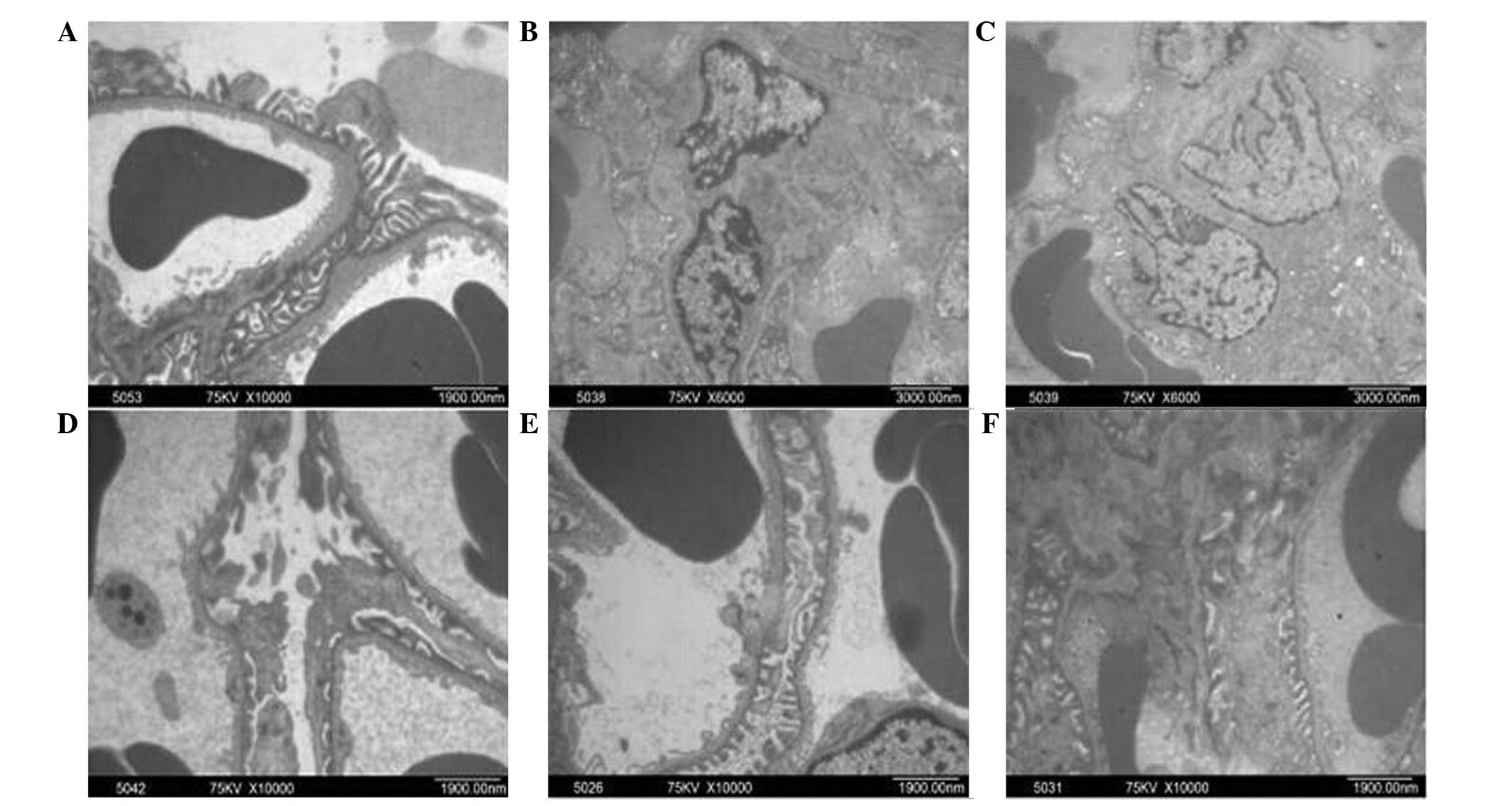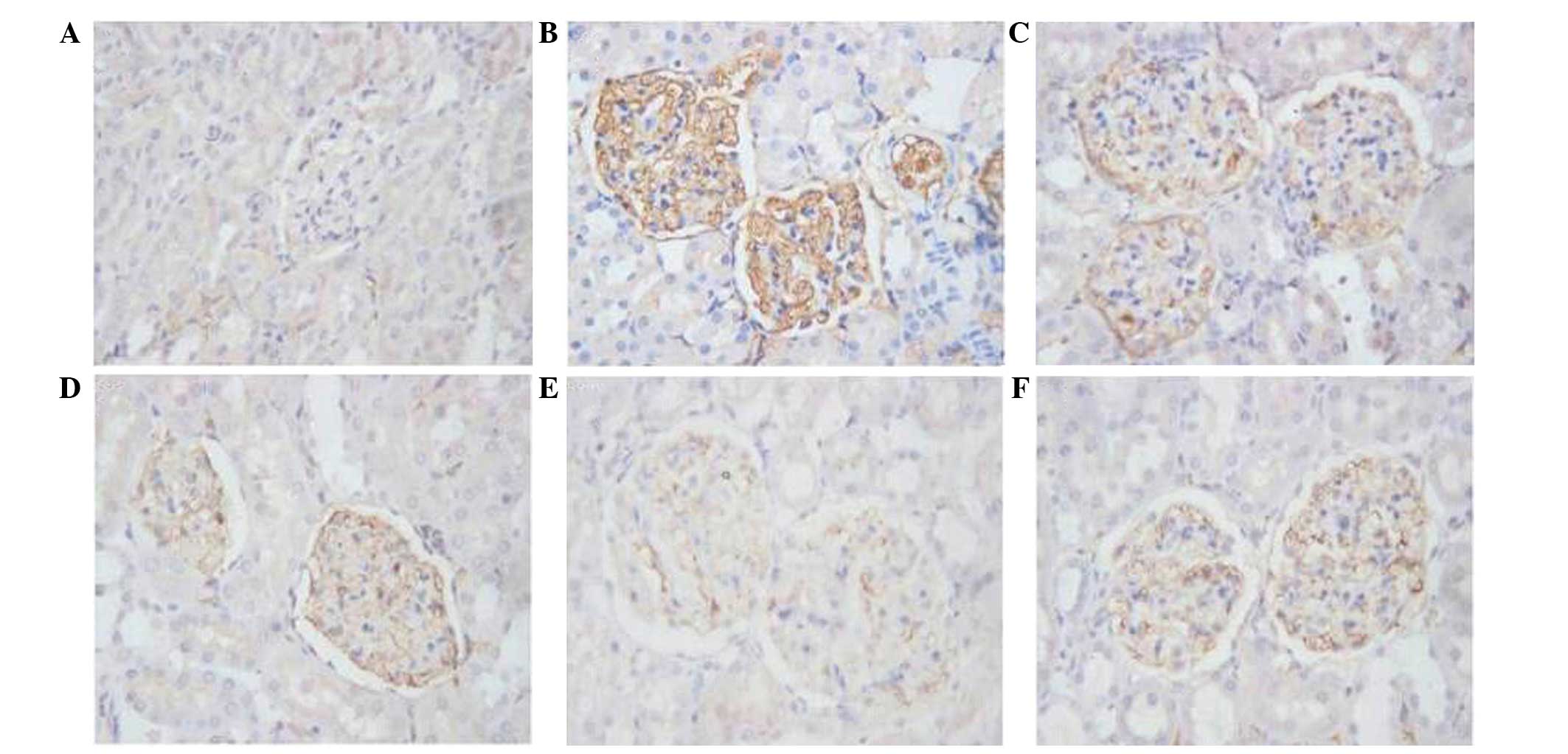|
1
|
Heerspink HJ and de Zeeuw D: The kidney in
type 2 diabetes therapy. Rev Diabet Stud. 8:392–402. 2011.
View Article : Google Scholar : PubMed/NCBI
|
|
2
|
Abuissa H and O'Keefe J Jr: The role of
renin-angiotensin-aldosterone system-based therapy in diabetes
prevention and cardiovascular and renal protection. Diabetes Obes
Metab. 10:1157–1166. 2008.PubMed/NCBI
|
|
3
|
Zhang WL, Zheng KY, Zhu KY, Zhan JY, Bi
CW, Chen JP, Dong TT, Choi RC, Lau DT and Tsim KW: Chemical and
biological assessment of angelica roots from different cultivated
regions in a chinese herbal decoction danggui buxue tang. Evid
Based Complement Alternat Med. 2013:4832862013. View Article : Google Scholar : PubMed/NCBI
|
|
4
|
Wu YC and Hsieh CL: Pharmacological
effects of Radix Angelica sinensis (Danggui) on cerebral
infarction. Chin Med. 6:322011. View Article : Google Scholar : PubMed/NCBI
|
|
5
|
Wang Z, Wang J and Chan P: Treating type 2
diabetes mellitus with traditional chinese and Indian medicinal
herbs. Evid Based Complement Alternat Med.
2013:3435942013.PubMed/NCBI
|
|
6
|
Toda S, Yase Y and Shirataki Y: Inhibitory
effects of astragali radix, crude drug in Oriental medicines on
lipid peroxidation and protein oxidative modification of mouse
brain homogenate by copper. Phytother Res. 14:294–296. 2000.
View Article : Google Scholar : PubMed/NCBI
|
|
7
|
Gao QT, Choi RC, Cheung AW, Zhu JT, Li J,
Chu GK, Duan R, Cheung JK, Jiang ZY, Dong XB, et al: Danggui buxue
tang - a Chinese herbal decoction activates the phosphorylations of
extracellular signal-regulated kinase and estrogen receptor alpha
in cultured MCF-7 cells. FEBS Lett. 581:233–240. 2007. View Article : Google Scholar : PubMed/NCBI
|
|
8
|
Zhang YW, Xie D, Xia B, Zhen RT, Liu IM
and Cheng JT: Suppression of transforming growth factor-beta1 gene
expression by Danggui buxue tang, a traditional Chinese herbal
preparation, in retarding the progress of renal damage in
streptozotocin-induced diabetic rats. Horm Metab Res. 38:82–88.
2006. View Article : Google Scholar : PubMed/NCBI
|
|
9
|
Zhang YW, Xie D, Chen YX, Zhang HY and Xia
ZX: Protective effect of Gui Qi mixture on the progression of
diabetic nephropathy in rats. Exp Clin Endocrinol Diabetes.
114:563–568. 2006. View Article : Google Scholar : PubMed/NCBI
|
|
10
|
Ha TS: Roles of adaptor proteins in
podocyte biology. World J Nephrol. 2:1–10. 2013. View Article : Google Scholar : PubMed/NCBI
|
|
11
|
Chiang YY, Takebayashi S and Oberley TD:
In vitro analysis of extracellular matrix production by porcine
glomerular mesangial and vascular smooth muscle cells. Am J Pathol.
138:1349–1358. 1991.PubMed/NCBI
|
|
12
|
Lan T, Liu W, Xie X, Xu S, Huang K, Peng
J, Shen X, Liu P, Wang L, Xia P and Huang H: Sphingosine kinase-1
pathway mediates high glucose-induced fibronectin expression in
glomerular mesangial cells. Mol Endocrinol. 25:2094–2105. 2011.
View Article : Google Scholar : PubMed/NCBI
|
|
13
|
Ke HL, Zhang YW, Zhou BF and Zhen RT:
Effects of Danggui Buxue Tang, a traditional Chinese herbal
decoction, on high glucose-induced proliferation and expression of
extracellular matrix proteins in glomerular mesangial cells. Nat
Prod Res. 26:1022–1026. 2012. View Article : Google Scholar : PubMed/NCBI
|
|
14
|
Bame KJ: Heparanases: endoglycosidases
that degrade heparan sulfate proteoglycans. Glycobiology.
11:91R–98R. 2011. View Article : Google Scholar
|
|
15
|
Jiang P, Kumar A, Parrillo JE, Dempsey LA,
Platt JL, Prinz RA and Xu X: Cloning and characterization of the
human heparanase-1 (HPR1) gene promoter: Role of GA-binding protein
and Sp1 in regulating HPR1 basal promoter activity. J Biol Chem.
277:8989–8998. 2002. View Article : Google Scholar : PubMed/NCBI
|
|
16
|
Gil N, Goldberg R, Neuman T, Garsen M,
Zcharia E, Rubinstein AM, van Kuppevelt T, Meirovitz A, Pisano C,
Li JP, et al: Heparanase is essential for the development of
diabetic nephropathy in mice. Diabetes. 61:208–216. 2012.
View Article : Google Scholar : PubMed/NCBI
|
|
17
|
Zhang YW, Wu CY and Cheng JT: Merit of
Astragalus polysaccharide in the improvement of early diabetic
nephropathy with an effect on mRNA expressions of NF-kappaB and
IkappaB in renal cortex of streptozotoxin-induced diabetic rats. J
Ethnopharmacol. 114:387–392. 2007. View Article : Google Scholar : PubMed/NCBI
|
|
18
|
Clark JD, Gebhart GF, Gonder JC, Keeling
ME and Kohn DF: Special report: Guide for the care and use of
laboratory animals. ILAR J. 1997:41–48. 1997. View Article : Google Scholar
|
|
19
|
Nakamura T, Terajima T, Ogata T, Ueno K,
Hashimoto N, Ono K and Yano S: Establishment and pathophysiological
characterization of type 2 diabetic mouse model produced by
streptozotocin and nicotinamide. Biol Pharm Bull. 29:1167–1174.
2006. View Article : Google Scholar : PubMed/NCBI
|
|
20
|
Schernthaner G, Grimaldi A, Di Mario U,
Drzewoski J, Kempler P, Kvapil M, Novials A, Rottiers R, Rutten GE
and Shaw KM: GUIDE study: Double-blind comparison of once-daily
gliclazide MR andglimepiride in type 2 diabetic patients. Eur J
Clin Invest. 34:535–542. 2004. View Article : Google Scholar : PubMed/NCBI
|
|
21
|
U.S. Food and Drug Administration:
Guidance for Industry and Reviewers: Estimating the Safe Starting
Dose in Clinical Trials for Therapeutics in Adult Healthy
Volunteers. December;2002.
|
|
22
|
Wang GG, Lu XH, Li W, Zhao X and Zhang C:
Protective effects of luteolin on diabetic nephropathy in
STZ-induced diabetic rats. Evid Based Complement Alternat Med.
2011:3231712011. View Article : Google Scholar : PubMed/NCBI
|
|
23
|
King AJ: The use of animal models in
diabetes research. Br J Pharmacol. 166:877–894. 2012. View Article : Google Scholar : PubMed/NCBI
|
|
24
|
Like AA and Rossini AA:
Streptozotocin-induced pancreatic insulitis: New model of diabetes
mellitus. Science. 193:415–417. 1976. View Article : Google Scholar : PubMed/NCBI
|
|
25
|
Kanwar YS, Wada J, Sun L, Xie P, Wallner
EI, Chen S, Chugh S and Danesh FR: Diabetic nephropathy: Mechanisms
of renal disease progression. Exp Biol Med (Maywood). 233:4–11.
2008. View Article : Google Scholar : PubMed/NCBI
|
|
26
|
Wolf G: New insights into the
pathophysiology of diabetic nephropathy: From haemodynamics to
molecular pathology. Eur J Clin Invest. 34:785–796. 2004.
View Article : Google Scholar : PubMed/NCBI
|
|
27
|
Dronavalli S, Duka I and Bakris GL: The
pathogenesis of diabetic nephropathy. Nat Clin Pract Endocrinol
Metab. 4:444–452. 2008. View Article : Google Scholar : PubMed/NCBI
|
|
28
|
Yeh CH, Chang CK, Cheng KC, Li YX, Zhang
YW and Cheng JT: Role of bone morphogenetic proteins-7 (BMP-7) in
the renal improvement effect of DangGui (Angelica sinensis)
in type-1 diabetic rats. Evid Based Complement Alternat Med.
2011:7967232011. View Article : Google Scholar : PubMed/NCBI
|
|
29
|
Giacco F and Brownlee M: Oxidative stress
and diabetic complications. Circ Res. 107:1058–1070. 2010.
View Article : Google Scholar : PubMed/NCBI
|
|
30
|
Zhong Y, Deng Y, Chen Y, Chuang PY and
Cijiang He J: Therapeutic use of traditional Chinese herbal
medications for chronic kidney diseases. Kidney Int. 84:1108–1118.
2013. View Article : Google Scholar : PubMed/NCBI
|
|
31
|
Zhang J, Xie X, Li C and Fu P: Systematic
review of the renal protective effect of Astragalus
membranaceus (root) on diabetic nephropathy in animal models. J
Ethnopharmacol. 126:189–196. 2009. View Article : Google Scholar : PubMed/NCBI
|
|
32
|
Chen X, Cao A, Wang L, Yin P, Zhang X and
Peng W: Prevention and treatment of diabetic nephropathy using
traditional Chinese medicine. J Integr Nephrol Androl. 1:53–57.
2014. View Article : Google Scholar
|
|
33
|
Wang H, Li J, Yu L, Zhao Y and Ding W:
Antifibrotic effect of the Chinese herbs, Astragalus
mongholicus and Angelica sinensis, in a rat model of
chronic puromycin aminonucleoside nephrosis. Life Sci.
74:1645–1658. 2004. View Article : Google Scholar : PubMed/NCBI
|
|
34
|
Shimomura H and Spiro RG: Studies on
macromolecular components of human glomerular basement membrane and
alterations in diabetes. Decreased levels of heparan sulfate
proteoglycan and laminin. Diabetes. 36:374–381. 1987. View Article : Google Scholar : PubMed/NCBI
|
|
35
|
Rops AL, van der Vlag J, Lensen JF,
Wijnhoven TJ, van den Heuvel LP, van Kuppevelt TH and Berden JH:
Heparan sulfate proteoglycans in glomerular inflammation. Kidney
Int. 65:768–785. 2004. View Article : Google Scholar : PubMed/NCBI
|
|
36
|
van den Hoven MJ, Rops AL, Bakker MA, Aten
J, Rutjes N, Roestenberg P, Goldschmeding R, Zcharia E, Vlodavsky
I, van der Vlag J and Berden JH: Increased expression of heparanase
in overt diabetic nephropathy. Kidney Int. 70:2100–2108. 2006.
View Article : Google Scholar : PubMed/NCBI
|
|
37
|
Shafat I, Agbaria A, Boaz M, Schwartz D,
Baruch R, Nakash R, Ilan N, Vlodavsky I and Weinstein T: Elevated
urine heparanase levels are associated with proteinuria and
decreased renal allograft function. PLoS One. 7:e440762012.
View Article : Google Scholar : PubMed/NCBI
|
|
38
|
Maxhimer JB, Somenek M, Rao G, Pesce CE,
Baldwin D Jr, Gattuso P, Schwartz MM, Lewis EJ, Prinz RA and Xu X:
Heparanase-1 gene expression and regulation by high glucose in
renal epithelial cells: A potential role in the pathogenesis of
proteinuria in diabetic patients. Diabetes. 54:2172–2178. 2005.
View Article : Google Scholar : PubMed/NCBI
|
|
39
|
van den Hoven MJ, Rops AL, Bakker MA, Aten
J, Rutjes N, Roestenberg P, Goldschmeding R, Zcharia E, Vlodavsky
I, van der Vlag J and Berden JH: Increased expression of heparanase
in overt diabetic nephropathy. Kidney Int. 70:2100–2108. 2006.
View Article : Google Scholar : PubMed/NCBI
|
|
40
|
Kramer A, van den Hoven M, Rops A,
Wijnhoven T, van den Heuvel L, Lensen J, van Kuppevelt T, van Goor
H, van der Vlag J, Navis G and Berden JH: Induction of glomerular
heparanase expression in rats with adriamycin nephropathy is
regulated by reactive oxygen species and the renin-angiotensin
system. J Am Soc Nephrol. 17:2513–2520. 2006. View Article : Google Scholar : PubMed/NCBI
|
|
41
|
Tan AL, Forbes JM and Cooper ME: AGE, RAGE
and ROS in diabetic nephropathy. Semin Nephrol. 27:130–143. 2007.
View Article : Google Scholar : PubMed/NCBI
|











